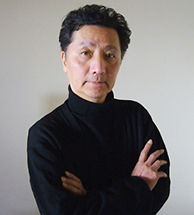- Message from AD
- Title / Concept
- Structure
- Visual Design
- Movie
Artistic Director / MORIMURA Yasumasa
The Conscience of Art / Art of the Unknown

©Morimura Yasumasa+ROJIAN
The future is unknown. But a ship has set sail from Yokohama Port, and to be completely honest, the journey is likely to be risky with me as the captain.
Being an artist, I’ve never had the chance to serve as the artistic director of any international exhibitions. I'm taking the wheel for the first time and the ship has already left port without my having had a chance to learn how to steer.
But it seems to me that this kind of slightly reckless launch is exactly what’s needed for an international exhibition today.
Since 2000, international exhibitions have sprung up everywhere, both in Japan and abroad, and there is no longer anything special or different about them. The scale is merely large. And the festive air is merely an amusement. Many are reduced to a symbol of populism, globalism, and localism. Market principles have exerted a consciously strong influence on the art world, prompting questions not only from those concerned but also from viewers. And though these people may still be in the minority, they are bound to increase as time goes by.
I’m not a fundamentalist, so I have no desire to unilaterally decide that art should be one way or another. And I would never opt for try to limit art by applying rigid constraints and eliminating all of the works that did not conform to them. But at the same time a total absence of rules would only lead to difficulties. Though I want to maintain a forum for free expression, I want to get rid of the idea that freedom should be the sole conviction.
So, what exactly are my convictions? I believe in the “conscience of art.” If there is a god of art, I would ask that the works that we present to him or her be offerings that can be presented without shame.
Thus, a professional curator, who knows that the key to success lies in one’s ability to deal with that head wind called “reality,” might see my views as little more than the dreams of an idealist and admonish me for being so naive in light of the fact that I have never assumed the weighty mantle of artistic director. And it’s true – having a childish artist whose only standards of value are dreams and ideals at the helm is extremely perilous. Yet with the outlook of an insecure novice trying to recapture the fading spirit of adventure, I'm setting out on this voyage with a fresh preparedness as I head into the unknown of the art world. And this in itself is sure to lead to some worthwhile proposals.
Though the nearly two-year journey will be a long one, I hope you can keep a close eye on the ship’s progress with a sense of curiosity and affection. I look forward to working with you all.
(Statement released on Dec.18, 2012)
Biography
Born 1951 in Osaka, where he continues to live and work.
Completed undergraduate and graduate degrees at Kyoto City University of Arts.
He made his debut in 1985 with self-portrait works based on his personal interpretation of Vincent Van Gogh. He has since produced a number of self-portraits in diligently staged photography and video works, identifying with art-historical images, famous film actresses, and iconic figures from the 20th century.
In 1988, Morimura was invited to take part in the Aperto section of the 43rd Venice Biennale, and over the years, he has participated in countless important exhibitions.
Selected solo exhibitions in Japan include, “The Sickness unto Beauty: Self-portrait as Actress” (Yokohama Museum of Art, 1996), “Self-Portrait as Art History” (Museum of Contemporary Art, Tokyo, and two other venues, 1998), Morimura Self-Portraits: An Inner Dialogue with Frida Kahlo (Hara Museum of Contemporary Art, Tokyo, 2001), “Bi [bi:]-Class, Be Quiet” (Contemporary Art Museum, Kumamoto, and Yokohama Museum of Art, 2007), and “A Requiem: Art on Top of the Battlefield” (Tokyo Metropolitan Museum of Photography, and three other venues, 2010 and 2011). His most recent solo exhibitions overseas is “Requiem for the XX Century: Twilight of the Turbulent Gods” (La Galleria di Piazza San Marco, Venice, and two other venues, 2007 and 2008), but has previously held shows in major museums in the United States, France, Spain, Australia, Thailand, and India.
His works are part of major national and public collections in Japan and also overseas, including Museo Nacional Centro de Arte Reina Sofia, Madrid, Museum of Contemporary Art, Chicago, Museum of Fine Art, Boston, and Queensland Art Gallery, Brisbane. He is a prolific writer, and author of many Japanese titled books. He has received a number of awards for his achievements, including Kyoto Prefecture Culture Prize, Merits Prize (2006), Minister of Education, Culture, Sports, Science and Technology’s Art Encouragement Prize of Fine Arts (2007), Photographic Society of Japan Awards, Lifetime Achievement Award (2011), and also one of the most prestigious awards in the field of art and science, Order of Purple Ribbon, Shiju Hosho (2011). He was also recently commended for a Person of Cultural Merit, Bunka Korosha, by Kyoto City (2013).